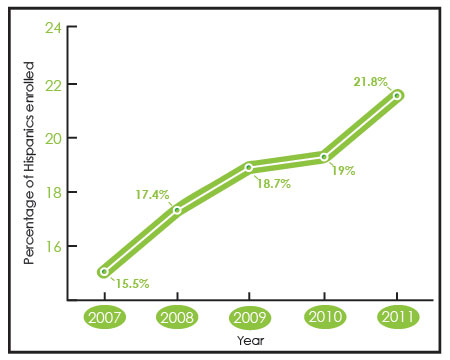Breaking the barriers
Hispanic enrollment on the rise

Rose Pulido
The Signal
College enrollment among Hispanics between the ages of 18 and 24 has increased by a record-breaking 24 percent between 2009 and 2010, based on a recent Pew Hispanic Center report.
This analysis of the Census Bureau data shows that Hispanics are the largest growing minority group in the U.S., which accounted for 16 percent of the population in 2010.
“We have this diverse stream of values and thoughts about higher education,” said Linda Contreras Bullock, the Texas Association of Chicanos in Higher Education president-elect and UHCL assistant dean of student diversity. “Anytime you talk to people about sending their kids to school they all say ‘yes, but’…there’s always that but. ‘We don’t have the money. We can’t afford it. We don’t want her to go away. We are protective over our kids.’…It’s not that we don’t value an education, it’s always those other outlying factors that go into the education.”
One of the primary factors why Hispanics have trailed behind in higher education is due to a lack of knowledge regarding the available resources.
“Finances in particular are a challenge, always have been, not just for Hispanics but for first-generation students in Texas generally,” said Dominic Chavez, senior director of external relations for the Texas Higher Education Coordinating Board. “A great number of students that are coming through our education pipeline are of limited means.”
Many first-generation students, including Hispanics, are not familiar with financial aid and how it can help assist with the cost of a higher education. Many lack the general knowledge of how to go about applying to a college and what steps need to be taken to successfully become enrolled at a university or a community college. Once students decide on the college they are attending, they have to go through a series of steps to meet the requirements requested by their college of choice.
“Going to college is complicated and particularly for foreign-born, young Hispanics, but also I would say Hispanics, whether they’re foreign born or native born, but if they have parents that are immigrants,” said Richard Fry, Pew Hispanic Center senior research associate. “They don’t have a parent, most likely, who has been to college themselves, and so they don’t have that family knowledge of how college works in America. I think that makes it difficult. That includes knowledge of financial aid.”
Along with a growing population, the report also lists educational strides as the second factor in why Hispanic enrollment has increased.
Bullock points out first-generation students face the difficult challenge of educating their parents, who have these reserved values because of a strong work ethic, about the importance and the benefits a higher education can provide.
“Growing up, my parent’s main concern was that I finish high school and start working,” said Monique Martinez, business management major and first-generation college student. “This seemed to be a huge accomplishment to them since they didn’t make it that far. To me it wasn’t enough and I wanted to accomplish more.”
Fry said the Census Bureau recently released numbers detailing what a typical Latino male and female will make as their work life earnings over a course of 40 years.
With a high school diploma, a Hispanic male will make approximately $1.3 million over a course of 40 years.
“Typical Hispanic male with an associate’s degree will earn about $1.8 million over his subsequent 40 years of work, and if that young Latino male completes a bachelor’s degree, he’d be expected to earn about $2.1 million over 40 years,” Fry said.
Fry also noted the work life earnings of a typical Hispanic female over the course of 40 years, that, in comparison, is less than a typical Hispanic male.
“If they finish high school and do not complete any further education, we’d expect them to earn a million dollars over the next 40 years, but a typical young Hispanic [female] with an associate’s degree earns about 1.4 million, an extra $400,000, and if she completes a bachelor’s degree, she’d be expected to earn about 1.7 million,” Fry said.
“I think, still, that there is that place where in our culture we have always valued the male as our provider,” Bullock said. “And so if we have to choose between the daughter and the son, I think they’re going to go with the son because they think the daughter can still get married and be supported.”
Martinez argues that although she comes from the typical household where her father provided for the family, she will not conform to the same cultural values in which she was raised.
“I want to be able to support myself,” Martinez said. “Traditions are changing, and I intend to work the same as my husband.”
Martinez said she now has the opportunity to be an ambassador for other students who are interested in attending to college and learning about available resources.
“I’m glad I’ve been given this opportunity,” Martinez said. “Since we are the fastest growing minority, I will have the opportunity to bring an educational awareness not only to my immediate family but also to my community.”


[…] am thrilled to read any article that touts the successes of Latinos, particularly at a time in our history when we are subject to […]